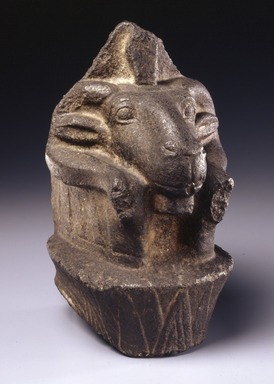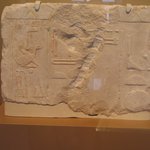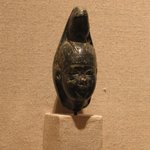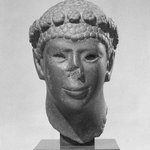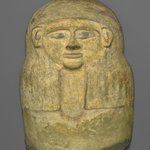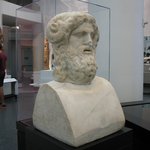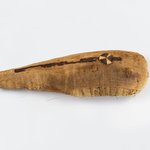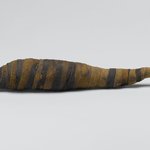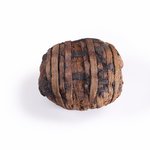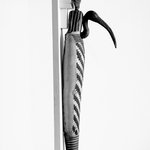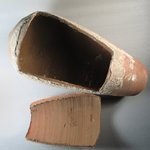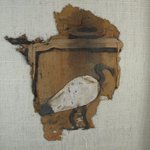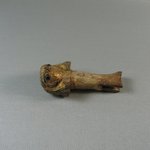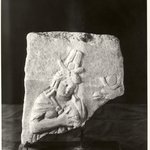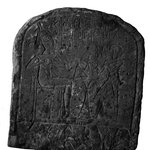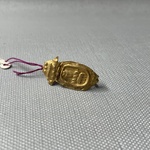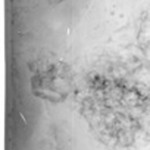

Ram-Headed Lotus Column (Amun), ca. 945–525 B.C.E. Black granite, pigment, 10 1/2 x 7 1/4 x 10 in., 26 lb. (26.7 x 18.4 x 25.4 cm, 11.79kg). Brooklyn Museum, Gift of Mrs. George D. Pratt, 35.932. Creative Commons-BY (Photo: Brooklyn Museum, 35.932_edited_SL3.jpg)
Ram-Headed Lotus Column (Amun)
Egyptian, Classical, Ancient Near Eastern Art
This image of a ram’s head represents a god, perhaps Amun, king of the gods. He wears two divine symbols: a uraeus-snake perched at his forehead and a sun disk (now damaged). When an animal wears divine symbols in Egyptian art, it indicates that it is associated with a god, emphasizing the special quality they share—in this case, the potency of the ram.
MEDIUM
Black granite, pigment
DATES
ca. 945–525 B.C.E.
DYNASTY
Dynasty 22 to Dynasty 26
PERIOD
Third Intermediate Period or Late Period
DIMENSIONS
10 1/2 x 7 1/4 x 10 in., 26 lb. (26.7 x 18.4 x 25.4 cm, 11.79kg) (show scale)
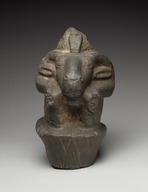


COLLECTIONS
Egyptian, Classical, Ancient Near Eastern Art
ACCESSION NUMBER
35.932
CREDIT LINE
Gift of Mrs. George D. Pratt
CATALOGUE DESCRIPTION
Ram-headed lotus column in black granite, a fragment from a large composition, probably of a priest or king holding this piece which was the sacred emblem of the great god Amen. The preserved portion contains the complete head of a ram bearing the uraeus with the long horns curved down front towards the chin. Behind and beneath the horns is the conventional wig; the head rests on a conventionalized lotus flower. On the top of the head are the remains of a ridge which connected the emblem with the hand or staff of the person depicted. The workmanship is good; traces of red paint remain in several places.
Condition: Ends of horns broken off, the uraeus chipped and various minor chips on lotus column.
MUSEUM LOCATION
This item is not on view
CAPTION
Ram-Headed Lotus Column (Amun), ca. 945–525 B.C.E. Black granite, pigment, 10 1/2 x 7 1/4 x 10 in., 26 lb. (26.7 x 18.4 x 25.4 cm, 11.79kg). Brooklyn Museum, Gift of Mrs. George D. Pratt, 35.932. Creative Commons-BY (Photo: Brooklyn Museum, 35.932_edited_SL3.jpg)
IMAGE
overall, 35.932_edited_SL3.jpg. Brooklyn Museum photograph
"CUR" at the beginning of an image file name means that the image was created by a curatorial staff member. These study images may be digital point-and-shoot photographs, when we don\'t yet have high-quality studio photography, or they may be scans of older negatives, slides, or photographic prints, providing historical documentation of the object.
RIGHTS STATEMENT
Creative Commons-BY
You may download and use Brooklyn Museum images of this three-dimensional work in accordance with a Creative Commons license. Fair use, as understood under the United States Copyright Act, may also apply.
Please include caption information from this page and credit the Brooklyn Museum. If you need a high resolution file, please fill out our online application form (charges apply).
For further information about copyright, we recommend resources at the United States Library of Congress, Cornell University, Copyright and Cultural Institutions: Guidelines for U.S. Libraries, Archives, and Museums, and Copyright Watch.
For more information about the Museum's rights project, including how rights types are assigned, please see our blog posts on copyright.
If you have any information regarding this work and rights to it, please contact copyright@brooklynmuseum.org.
RECORD COMPLETENESS
Not every record you will find here is complete. More information is available for some works than for others, and some entries have been updated more recently. Records are frequently reviewed and revised, and we welcome any additional information you might have.
